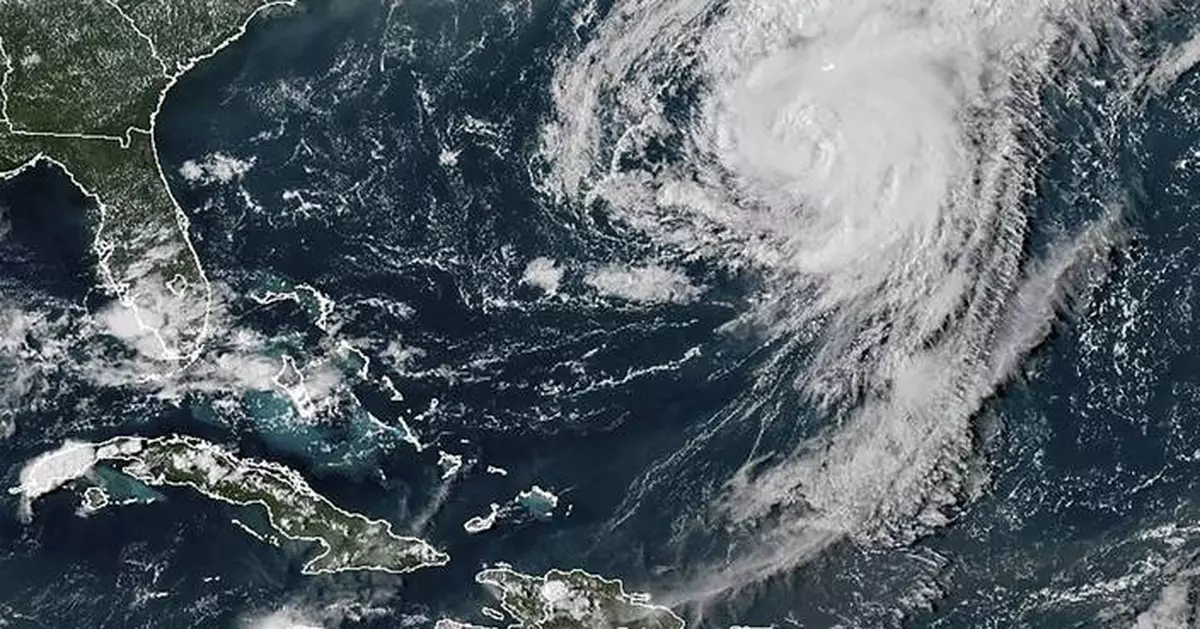MEXICO CITY (AP) — Hurricane Ernesto weakened into a tropical storm late Saturday as it moved away from Bermuda over open waters of the Atlantic after crossing over the tiny British territory early in the day with heavy rains and strong winds.
Ernesto forced residents to stay indoors, and more than 23,000 people lost power, officials said. By late Saturday, the storm's maximum sustained winds had decreased to 70 mph (110 kph). It was centered about 140 miles (225 kilometers) northeast of Bermuda and moving north-northeast at 8 mph (13 kph).
The National Hurricane Center had warned of strong winds, a dangerous storm surge and significant coastal flooding for Bermuda.
The center said 7 to 9 inches (17-22.5 centimeters) of rain was expected to fall on Bermuda. “This rainfall will likely result in considerable life-threatening flash flooding, especially in low-lying areas on the island,” it said.
Due to the large size of the storm and its slow movement, gusts sometimes up to hurricane force were expected through Saturday night and tropical storm-strength winds were expected to continue well into Sunday, the Bermuda government said.
Late Saturday afternoon, Michelle Pitcher, director of the Bermuda Weather Service, said wind gusts were still reaching hurricane force. “It’s still quite rough out there,” she said.
A tropical storm warning would remain in place into the night, Pitcher said.
Premier David Burt shared a video on the social media platform X thanking emergency services and encouraging residents to stay inside.
“Overnight, there will still be tropical storm force winds, and we’re asking everyone to please exercise caution,” he said. “Remain at home.”
BELCO, Bermuda's power company, said over 23,000 customers had no power as of Saturday night.
The hurricane center reported life-threatening surf and rip currents on the East Coast of the United States and Canada. Ernesto was expected to pass near southeastern Newfoundland by Monday night, and possibly could regain hurricane strength, it said.
Lana Morris, manager of Edgehill Manor Guest House in Bermuda, said conditions were calm, though the wind has started to pick up again. “I spoke to my guests, they told me they still have electricity, they have running water, and are comfortable.”
Morris said she has been communicating with her guests via phone. “They do not have internet — but if the network is down, it’s down. They are safe and I’m happy with that.”
Bermuda is an archipelago of 181 tiny islands whose total land mass is roughly the size of Manhattan.
According to AccuWeather, it’s uncommon for the eye of a hurricane to make landfall in Bermuda. It noted that, before today, since 1850 only 11 of 130 tropical storms that came within 100 miles (160 kilometers) of Bermuda had made landfall.
The territory is a renowned offshore financial center with sturdy construction, and given its elevation, storm surge is not as problematic as it is with low-lying islands.
Ernesto previously battered the northeast Caribbean, where it left tens of thousands of people without water in Puerto Rico.
LUMA, Puerto Rico's national power company, said it had restored more than 1.3 million customers' electricity 72 hours after the storm's passage.
After cleaning up and removing debris, the Virgin Islands Department of Education said all public schools would resume operations Monday.
Classes in Puerto Rico's public schools also were scheduled to start Monday, nearly a week after their original date.
Ernesto is the fifth named storm and the third hurricane of this year’s Atlantic hurricane season.
The National Oceanic and Atmospheric Administration has predicted an above-average Atlantic hurricane season this year because of record warm ocean temperatures. It forecast 17 to 25 named storms, with four to seven major hurricanes.
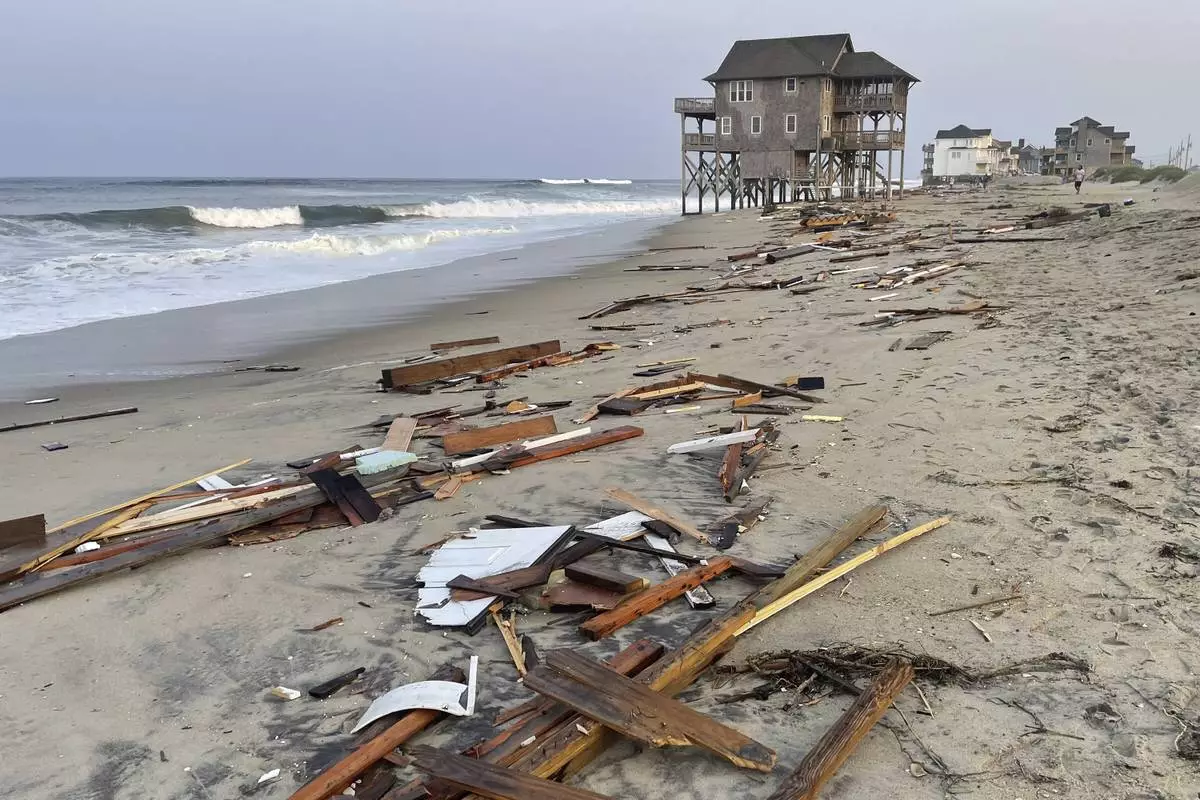
This photo provided by the National Park Service on Friday, Aug. 16, 2024, in Rodanthe, N.C., along the Cape Hatteras National Seashore shows debris from an unoccupied beach house that collapsed into the Atlantic Ocean from winds and waves caused by Hurricane Ernesto. (Cape Hatteras National Seashore via AP)
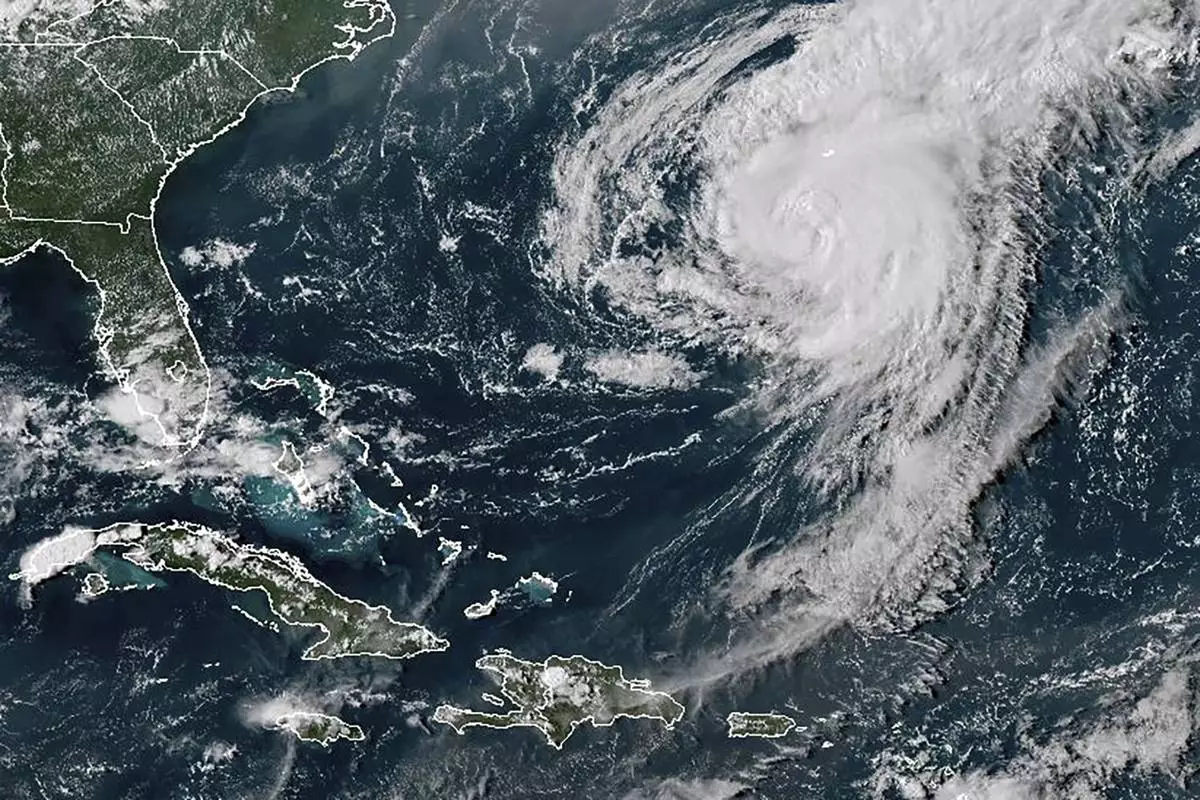
This GOES-16 GeoColor satellite image taken at 4:40 p.m EDT and provided by National Oceanic and Atmospheric Administration (NOAA) shows Hurricane Ernesto in the Atlantic Ocean south-southwest of Bermuda, Friday, Aug. 16, 2024. (NOAA via AP)
NEW YORK (AP) — U.S. stock indexes stormed back from big early drops to finish higher, led by a handful of highly influential Big Tech companies. The S&P 500 gained 1.1% Wednesday after erasing a morning wipeout of 1.6%. A majority of the index’s stocks still finished lower for the day, but gains for Nvidia and other tech stocks were enough to drive it to a third straight gain and back within 2% of its all-time high set in July. The Dow Jones Industrial Average rose by 124 points, or 0.3%, after rallying back from a drop of 743 points. The Nasdaq composite jumped 2.2%.
THIS IS A BREAKING NEWS UPDATE. AP’s earlier story follows below.
NEW YORK (AP) — Most U.S. stocks are falling Wednesday as traders scale back their expectations for how much relief the Federal Reserve will deliver next week when it begins cutting interest rates.
Seven out of every 10 stocks were sinking within the S&P 500, but the index was nevertheless 0.4% higher in afternoon trading after erasing a sharp slide from earlier in the morning. The gain was due almost entirely to the performance of just one highly influential stock: Nvidia.
The Dow Jones Industrial Average was down 76 points, or 0.2%, as of 2:30 p.m. Eastern time, after erasing almost all of an earlier drop of 743 points. The Nasdaq composite, meanwhile, was up 1.4% thanks to Nvidia and a handful of other Big Tech stocks.
The sharp see-saw trading, where the Nasdaq composite roared back from an earlier 1.4% slide, followed the government's latest update on inflation at the consumer level, which came in close to expectations. Overall inflation slowed to 2.5% in August from 2.9% in July, a touch better than expected. But prices rose more than expected from July into August when ignoring food and energy, and economists say that can be a better predictor of where inflation is heading.
All together, the data seemed to confirm that the Fed will indeed cut its main interest rate at its meeting next week, which would be the first such cut in more than four years. But it bolstered expectations that the Fed will begin with only a traditional-sized move of a quarter of a percentage point instead of the more severe half-point that some had been expecting.
“This isn’t the CPI report the market wanted to see,” said Seema Shah, chief global strategist at Principal Asset Management.
Investors have a long history of being overly optimistic about how much and when the Fed will cut interest rates, only to send stock prices lower after being confronted with reality. Wall Street loves lower rates because they can goose the economy by making it cheaper for U.S. companies and households to borrow. Cuts also give boosts to investment prices.
The downside of lower rates is that they can give inflation more fuel.
“We believe the market is pricing in more rate cuts than what will occur this year,” said Gargi Chaudhuri, chief investment and portfolio strategist, Americas at BlackRock.
This time, the Fed at least has already indicated it’s about to begin lowering interest rates as it shifts from fighting high inflation toward protecting the job market and keeping the economy out of a recession. With inflation down from its peak of 9.1% two summers ago, the Fed is hoping to ease the brakes off the already slowing economy.
A worry on Wall Street is that the cuts may prove to be too late, with many U.S. shoppers already struggling under the weight of high prices and stretched ability to spend more.
Vera Bradley’s stock dropped 5.9% after the designer of handbags and the parent company of the Pura Vida brand reported weaker profit and revenue for the latest quarter than analysts expected. It pointed to “stubbornly persistent macro consumer headwinds.”
Elsewhere on Wall Street, Trump Media & Technology Group sank 11.3% to worsen its rough run since March. The company behind former President Donald Trump’s Truth Social platform has often risen and fallen with expectations for Trump’s re-election chances, and he’s coming off a debate with Vice President Kamala Harris.
Since closing above $66 in early March, the stock has tumbled to $16.53. That affects Trump particularly because he is the company’s largest shareholder.
On the winning side of the U.S. stock market were solar-energy companies, which are seen as doing better under a Democratic White House than a Republican one. First Solar jumped 14.4%.
Big Tech also once again lifted the market. A handful of these behemoths have pulled away from the rest of the stock market, accounting for most of the S&P 500's return through the early part of this year, in large part on hopes about profits coming from the artificial-intelligence boom.
They faltered during the summer on worries that investors had carried the stock prices too high, including a 27% drop for Nvidia at one point, but they've been firming in the last couple weeks.
Beside the 6.8% rise for Nvidia, gains of 1.5% for Amazon and 1.5% for Microsoft were also big forces lifting the S&P 500. Because these companies are among Wall Street's largest by market value, their movements pack more punch on the index than almost every other stock.
In the bond market, the yield on the 10-year Treasury rose to 3.66% from 3.64% late Tuesday. The two-year yield, which more closely follows expectations for Fed action, rose more, to 3.65% from 3.59%.
In stock markets abroad, indexes fell across much of Europe and Asia.
Japan’s Nikkei 225 dropped 1.5% after a Japanese central bank official was quoted by Japanese media as indicating the Bank of Japan was getting ready to raise interest rates. The comments also pushed the value of the Japanese yen higher against the U.S. dollar, a move that earlier in the summer helped send financial markets around the world reeling.
AP Business Writers Yuri Kageyama and Matt Ott contributed.
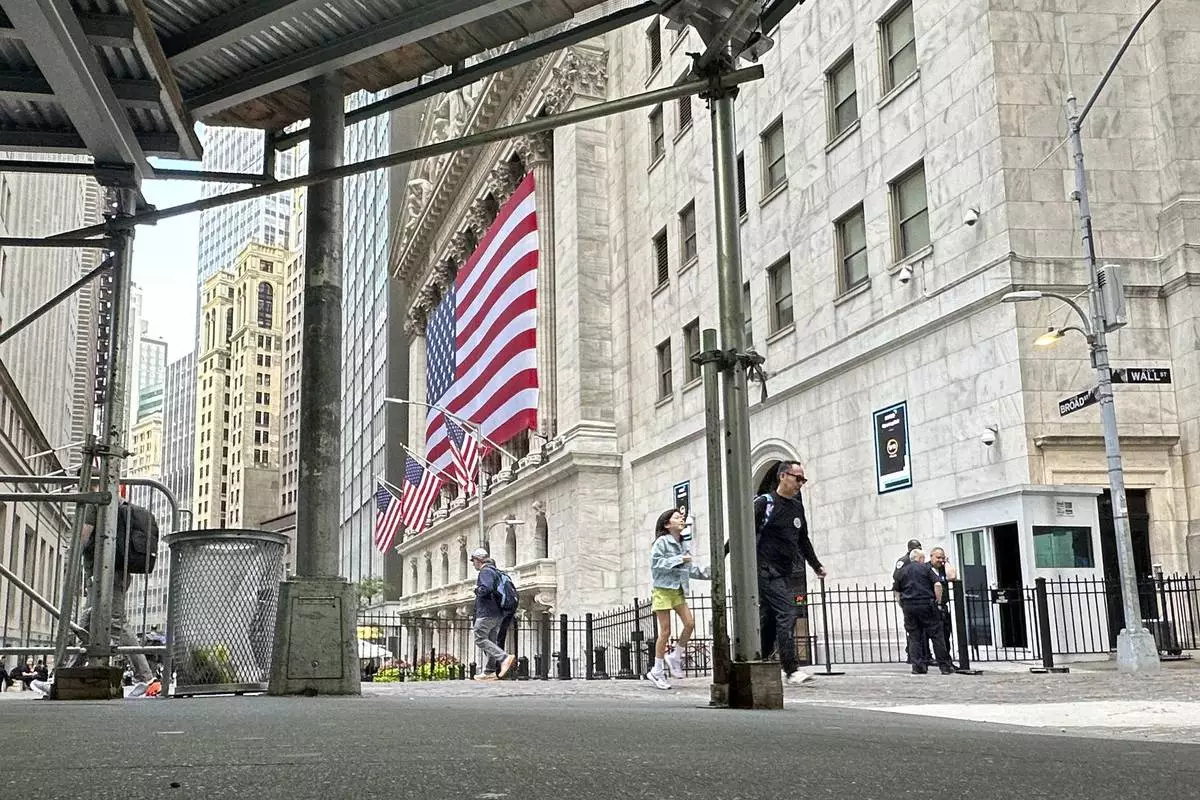
The American flag hangs from the front of the New York Stock Exchange on Wednesday, Sept. 11, 2024, in New York. (AP Photo/Peter Morgan)
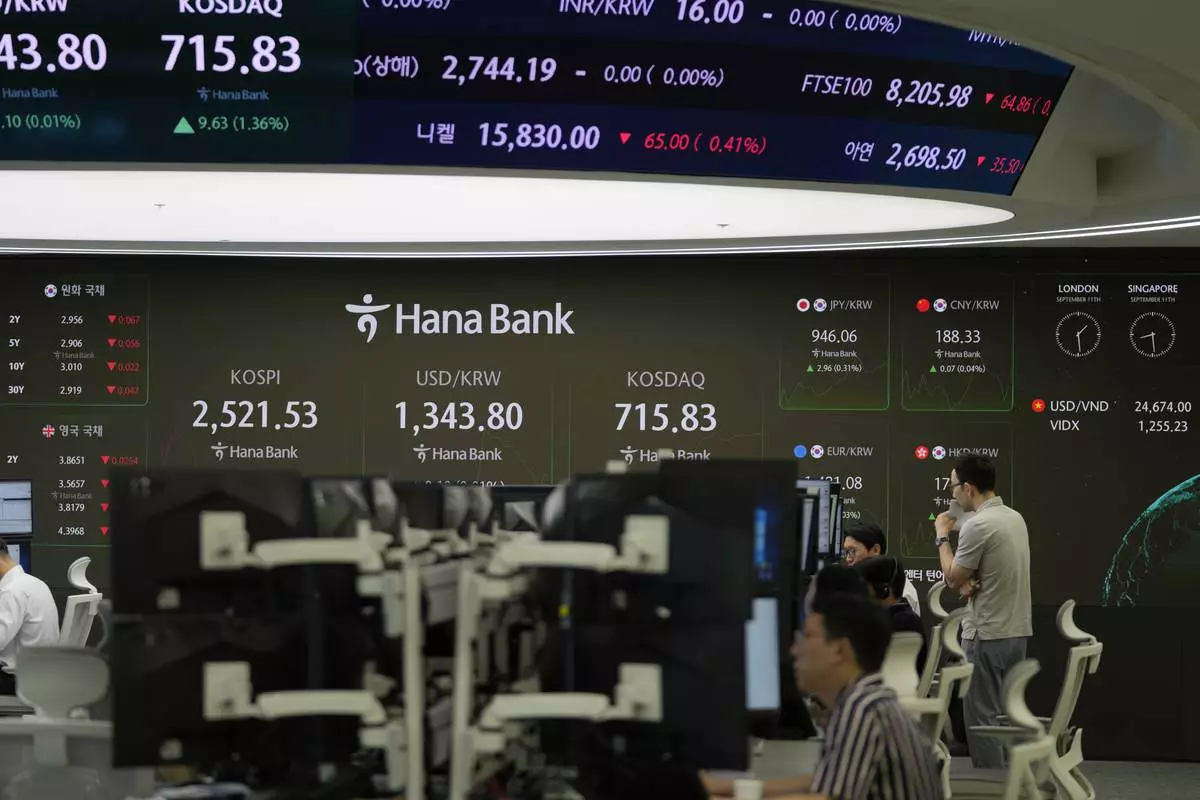
Currency traders talk near the screens showing the Korea Composite Stock Price Index (KOSPI), left, the foreign exchange rate between U.S. dollar and South Korean won and the Korean Securities Dealers Automated Quotations (KOSDAQ), at a foreign exchange dealing room in Seoul, South Korea, Wednesday, Sept. 11, 2024. (AP Photo/Lee Jin-man)

Currency traders talk near the screens showing the Korea Composite Stock Price Index (KOSPI), left, the foreign exchange rate between U.S. dollar and South Korean won and the Korean Securities Dealers Automated Quotations (KOSDAQ), at a foreign exchange dealing room in Seoul, South Korea, Wednesday, Sept. 11, 2024. (AP Photo/Lee Jin-man)

A currency trader walks by the screens showing the foreign exchange rate between U.S. dollar and South Korean won at a foreign exchange dealing room in Seoul, South Korea, Wednesday, Sept. 11, 2024. (AP Photo/Lee Jin-man)
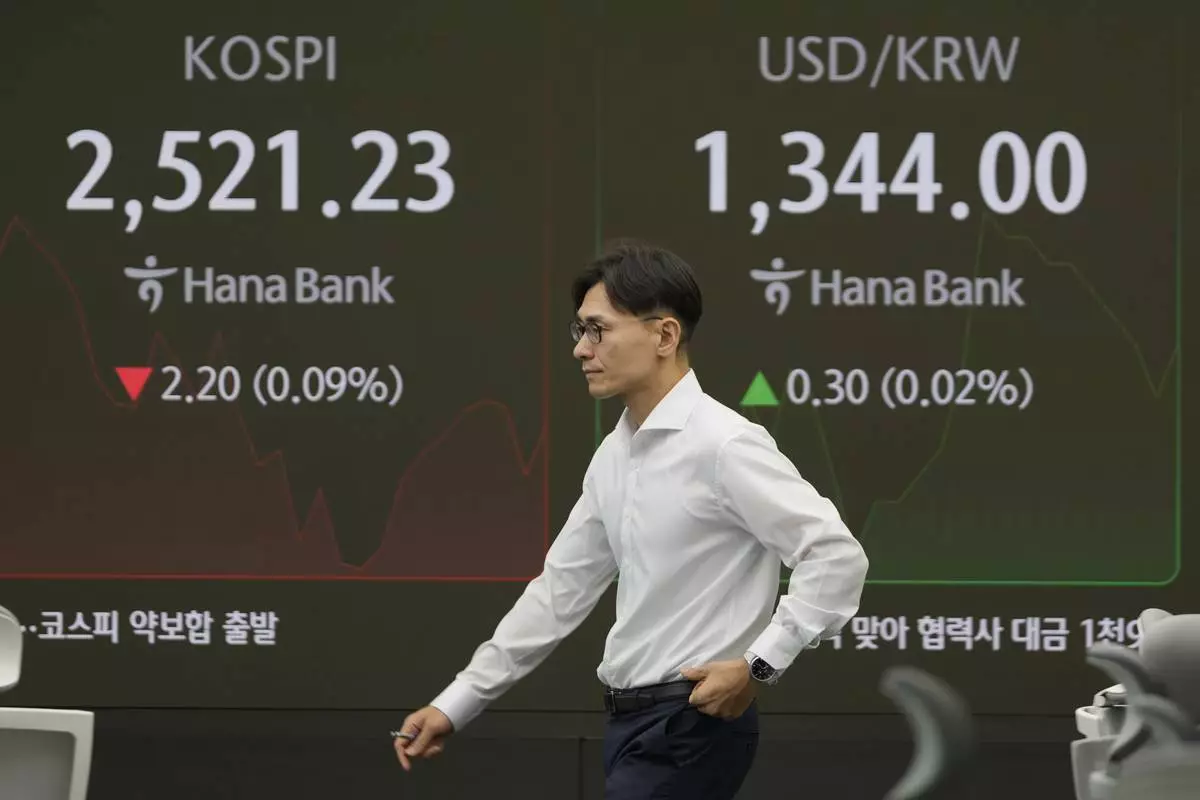
A currency trader walks by the screens showing the Korea Composite Stock Price Index (KOSPI), left, and the foreign exchange rate between U.S. dollar and South Korean won at a foreign exchange dealing room in Seoul, South Korea, Wednesday, Sept. 11, 2024. (AP Photo/Lee Jin-man)




